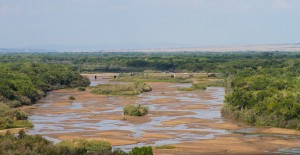The status of the endangered Rio Grande silvery minnow raises some fascinating transboundary questions. As water moves across state boundaries, who bears responsibility when upstream actions affect an endangered species in a downstream state?
The fish, once found from the mountains of northern New Mexico to the Gulf of Mexico, is gone from all but the stretch of the Rio Grande between Cochiti Reservoir and Elephant Butte Reservoir in New Mexico (plus an experimental population in Big Bend National Park in Texas). Since the experimental population doesn’t really count for regulatory purposes, the real meat of the ESA action has always been in New Mexico. That’s where the remaining fish are, and therefore that’s where the legal responsibility for saving the fish lies.
The fish has already been extirpated from southern New Mexico and Texas, so those folks are off the hook. Because they’ve already killed off their minnows, they bear no responsibility for saving the rest. Upstream, Colorado has thus far borne no responsibility either. It could be argued that their water use, before the Rio Grande reaches the minnows’ current habitat, contributes to the stress on the little fish. But so far, all responsibility for maintaining the fish, and if necessary providing the water to do that, lies with water management agencies in central New Mexico.
But in an action filed this week, the environmental group WildEarth Guardians is pushing against that status quo:
Colorado’s use of Rio Grande water is depriving the river of spring flows needed to keep the endangered Rio Grande silvery minnow alive, an environmental group charged in a legal notice filed this week.
The notice by the Santa Fe-based group WildEarth Guardians opens a new legal front in the struggle over environmental flows in the Rio Grande, a struggle that until now had focused on tradeoffs among water interests within New Mexico.
UNM law professor Reed Benson lays out the key legal questions:
This would be an unusual case, but not a unique one. Most ESA cases involving harm to protected species are brought against federal agencies, under a different part of the law applicable only to them. There have been some similar cases to this one, however, where courts have held that state or local governments caused take. Notably, a federal court in Texas recently found that inadequate water management by the State of Texas took endangered whooping cranes by drying out their winter habitat. (That decision has been stayed and is now on appeal; watch this space for further developments.) These cases establish that state governments may violate section 9 if they allow private activities that result in take.
I encourage you to click through to Reed’s piece. My newspaper stories often rely on his analysis. Now you can just cut out the middleman and read him directly.


Pingback: Another Week in the Ecological Crisis, January 26, 2014 – A Few Things Ill Considered